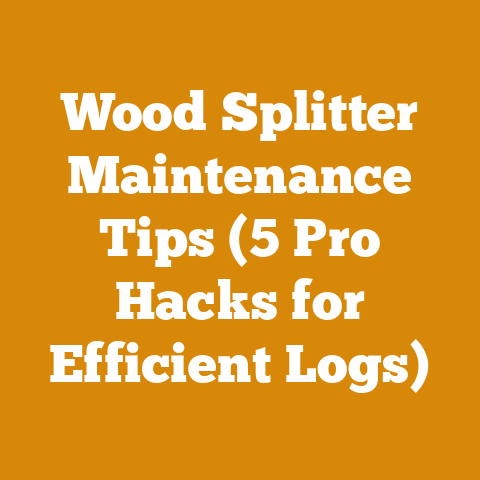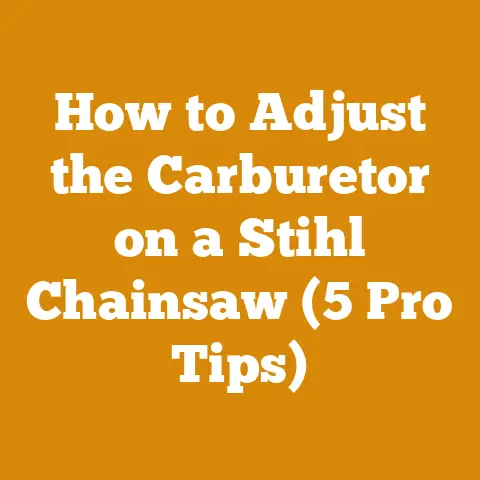Hardwood Flooring Milling Machine Tips (Pro Tricks for Perfect Cuts)
Imagine the satisfying click of perfectly milled hardwood flooring planks locking into place, the smooth, even surface underfoot, the warm, inviting glow it casts across your home. Achieving that level of perfection starts long before installation, with the milling process. And if you’re considering milling your own hardwood flooring, you’re likely aiming for both cost savings and the unparalleled satisfaction of crafting something beautiful and functional from raw materials. But getting it right requires more than just a machine; it demands knowledge, skill, and a few pro tricks up your sleeve.
This article dives deep into the world of hardwood flooring milling, focusing on the tips and techniques that separate amateur attempts from professional-grade results. We’ll explore everything from machine selection and setup to wood selection, cutting strategies, and cost considerations. I’ll share my experiences, both successes and hard-learned lessons, gleaned from years of working with wood, along with actionable advice to help you master this rewarding skill. Prepare to unlock the secrets to perfect cuts and stunning hardwood floors.
Hardwood Flooring Milling Machine Tips (Pro Tricks for Perfect Cuts)
Why Mill Your Own Hardwood Flooring? Weighing the Pros and Cons
Before we get into the nitty-gritty, let’s address the elephant in the room: why mill your own flooring in the first place? The allure is strong: custom wood species, tailored dimensions, potentially significant cost savings, and the deep satisfaction of creating something from scratch. I’ve personally milled flooring for several projects, including a stunning walnut floor for my study. The character and warmth it added were unmatched by anything I could have bought pre-made.
However, it’s not all sunshine and roses. Milling your own flooring requires a significant investment in time, equipment, and learning. There’s a steep learning curve, and mistakes can be costly. Consider these factors:
- Pros:
- Cost Savings: Potentially lower material costs if you have access to affordable timber or salvaged wood. I’ve saved up to 40% on material costs in some instances by sourcing locally harvested trees.
- Customization: Unparalleled control over wood species, dimensions (width, thickness, length), and finish. Want extra-wide planks of reclaimed heart pine? Milling your own lets you do it.
- Quality Control: You dictate the quality of the wood and the milling process. No hidden defects or compromises on craftsmanship.
- Satisfaction: The immense pride of creating a beautiful, functional floor from raw materials.
- Sustainability: Opportunity to use locally sourced and sustainably harvested wood.
- Cons:
- Initial Investment: Significant upfront cost for a milling machine and related equipment (planer, jointer, moisture meter, etc.). I initially spent around $5,000 on my basic setup.
- Time Commitment: Milling is a time-consuming process. Expect to spend hours, even days, preparing the wood, milling the planks, and finishing them.
- Learning Curve: Mastering the techniques required for consistent, high-quality results takes time and practice.
- Waste: There will be some waste material, which can add to the overall cost if not managed properly. I aim for a waste factor of less than 10% by carefully planning my cuts.
- Storage: You’ll need adequate space to store the lumber before and after milling. Proper storage is crucial to prevent warping and other damage.
Ultimately, the decision to mill your own flooring depends on your individual circumstances, budget, and commitment. If you’re looking for a quick and easy solution, pre-finished flooring is the way to go. But if you’re willing to invest the time and effort, milling your own can be a deeply rewarding experience.
Understanding the Costs: A Detailed Breakdown
One of the biggest motivators for milling your own flooring is potential cost savings. However, it’s crucial to understand the costs involved to determine if it’s truly a financially viable option. I’ve broken down the major cost components below, along with real-world examples and data points.
1. Raw Material Costs (Timber/Lumber)
This is arguably the most significant cost factor. Prices vary dramatically depending on the wood species, grade, and source.
- Wood Species: Hardwoods like oak, maple, walnut, and cherry are typically more expensive than softwoods like pine or fir. Exotic hardwoods can command premium prices.
- Grade: Lumber is graded based on the presence of knots, blemishes, and other defects. Higher grades (e.g., FAS – First and Seconds) are more expensive but yield more usable material.
- Source: Sourcing directly from a local sawmill or logging operation can often be cheaper than buying from a retail lumberyard. Salvaged or reclaimed wood can also be a cost-effective option.
Data Points:
- Oak (Red or White): Expect to pay between $3 to $7 per board foot, depending on grade and location. According to the USDA Forest Service, the average price for standing oak timber in the US ranges from $200 to $500 per thousand board feet, but this doesn’t include harvesting and milling costs.
- Maple (Hard): Prices typically range from $4 to $8 per board foot.
- Walnut (Black): A premium hardwood, walnut can cost anywhere from $8 to $20+ per board foot.
- Pine (Eastern White): A more affordable option, pine typically costs between $1.50 to $3 per board foot.
My Experience:
I once sourced rough-sawn walnut directly from a local tree farm for $6 per board foot. The retail price for kiln-dried walnut at the time was $15 per board foot. The savings were substantial, but it required extra effort to dry and mill the lumber myself.
Cost Calculation Example:
Let’s say you need 500 board feet of oak flooring. At an average price of $5 per board foot, the raw material cost would be $2,500.
2. Equipment Costs
This is where the initial investment comes in. You’ll need a milling machine, as well as other essential tools.
- Milling Machine (Moulder): This is the core of your operation. Prices range from a few thousand dollars for a basic model to tens of thousands for a professional-grade machine. Consider a used machine to save money.
- Planer: Used to flatten and smooth the lumber. Prices range from a few hundred dollars for a benchtop model to several thousand for a larger, industrial planer.
- Jointer: Used to create a perfectly flat edge on the lumber. Similar price range to planers.
- Moisture Meter: Essential for monitoring the moisture content of the wood. A good quality moisture meter costs between $100 and $300.
- Sawmill (Optional): If you’re starting with logs, you’ll need a sawmill to break them down into lumber. Portable sawmills can be rented or purchased, but they represent a significant investment.
- Other Tools: Measuring tools, safety equipment (eye protection, hearing protection, dust mask), clamps, etc.
Data Points:
- Used Milling Machine: Expect to pay between $2,000 and $10,000 for a used milling machine in good condition.
- New Benchtop Planer: Prices range from $300 to $800.
- New Benchtop Jointer: Prices range from $300 to $800.
- Portable Sawmill Rental: Rental fees typically range from $200 to $500 per day.
My Experience:
I started with a used milling machine that I purchased for $3,500. It required some repairs and adjustments, but it was a cost-effective way to get started. I also invested in a good quality planer and jointer, as these are crucial for achieving consistent results.
Cost Calculation Example:
- Used Milling Machine: $3,500
- Planer: $500
- Jointer: $500
- Moisture Meter: $200
- Total Equipment Cost: $4,700
3. Labor Costs
If you’re doing all the work yourself, labor costs are essentially the value of your time. If you’re hiring someone to help, you’ll need to factor in their hourly wage.
- Your Time: Be realistic about how much time it will take to mill the flooring. Factor in time for sourcing materials, setting up the equipment, milling the planks, and finishing them.
- Hired Labor: If you’re hiring someone to help, expect to pay between $20 and $50 per hour, depending on their experience and skill level.
Data Points:
- Average Hourly Wage for Woodworkers: According to the Bureau of Labor Statistics, the median hourly wage for woodworkers in the United States was $17.57 in May 2023. However, this can vary depending on location and experience.
My Experience:
I typically spend 40-60 hours milling enough flooring for a small room (100-200 square feet). If I were to pay someone to do this work, it would easily cost several thousand dollars.
Cost Calculation Example:
- Your Time: 50 hours
- Value of Your Time (estimated at $30/hour): $1,500
4. Consumables and Maintenance
These are the ongoing costs associated with running your milling operation.
- Cutting Tools: Milling machine knives, planer blades, jointer knives. These need to be sharpened or replaced periodically.
- Sandpaper: For sanding the flooring planks.
- Finishes: Stain, sealant, polyurethane, etc.
- Lubricants: For maintaining the milling machine and other equipment.
- Electricity: The cost of running the equipment.
- Repairs: Unexpected repairs to the milling machine or other equipment.
Data Points:
- Cost of Sharpening Milling Machine Knives: Typically ranges from $20 to $50 per knife.
- Cost of Replacing Planer Blades: A set of planer blades can cost between $50 and $200.
My Experience:
I budget approximately $200 per year for consumables and maintenance. This covers the cost of sharpening knives, replacing blades, and purchasing sandpaper and finishes.
Cost Calculation Example:
- Consumables and Maintenance: $200 per year
5. Other Costs
These are miscellaneous costs that may not be immediately apparent.
- Transportation: The cost of transporting the lumber to your workshop.
- Storage: The cost of renting or building a storage space for the lumber.
- Permits: Depending on your location, you may need permits to operate a milling machine.
- Insurance: Liability insurance to protect yourself in case of accidents.
My Experience:
I have a dedicated workshop space, so I don’t have to pay for storage. However, I do factor in the cost of transportation and insurance.
Total Cost Calculation Example
Let’s combine all the cost components to estimate the total cost of milling 500 board feet of oak flooring:
- Raw Material Costs (Oak): $2,500
- Equipment Costs (Amortized over 5 years): $4,700 / 5 = $940
- Labor Costs (Your Time): $1,500
- Consumables and Maintenance: $200
- Other Costs (Transportation, Insurance): $100
Total Estimated Cost: $5,240
Cost per Board Foot: $5,240 / 500 = $10.48
In this example, the cost of milling your own oak flooring is $10.48 per board foot. This is higher than the average retail price of oak flooring ($3-$7 per board foot), but it doesn’t account for the added value of customization and quality control. Furthermore, the equipment costs are amortized over five years. If you plan to mill more flooring in the future, the cost per board foot will decrease significantly.
Key Takeaway:
Thoroughly analyze all cost components before embarking on a hardwood flooring milling project. Consider your individual circumstances and adjust the calculations accordingly. Don’t underestimate the value of your time and the potential for unexpected expenses.
Machine Selection: Choosing the Right Tool for the Job
The heart of any hardwood flooring milling operation is the milling machine itself. Choosing the right machine is crucial for achieving consistent, high-quality results. There are several types of milling machines available, each with its own strengths and weaknesses.
- Moulder: A moulder is specifically designed for shaping wood. It uses a series of rotating cutters to create complex profiles, such as tongue-and-groove joints. Moulders are ideal for milling flooring because they can produce consistent and accurate results.
- Planer/Jointer Combination: A planer/jointer combination is a versatile tool that can be used for both flattening and smoothing lumber. While not as specialized as a moulder, it can be a cost-effective option for smaller projects.
- Shaper: A shaper is similar to a moulder, but it typically has a single cutter head. Shapers can be used to create a variety of profiles, but they require more skill and experience to operate than moulders.
Factors to Consider When Choosing a Milling Machine:
- Project Size: For small projects, a planer/jointer combination may be sufficient. For larger projects, a moulder is the best option.
- Budget: Milling machines range in price from a few thousand dollars to tens of thousands of dollars. Consider your budget when choosing a machine.
- Wood Species: Some milling machines are better suited for certain wood species than others. If you plan to mill a variety of wood species, choose a machine that is versatile enough to handle them all.
- Features: Look for features such as variable speed control, automatic feed, and dust collection. These features can make the milling process easier and more efficient.
- Used vs. New: Buying a used milling machine can save you money, but be sure to inspect it carefully before you buy it. Check for wear and tear, and make sure that all the parts are in good working order.
My Experience:
I started with a used moulder that I purchased for $3,500. It was an older model, but it was in good working condition. I upgraded to a newer moulder a few years later, but the used machine served me well for many years.
Pro Tip:
Before you buy a milling machine, try it out. Ask the seller if you can bring a piece of lumber and run it through the machine. This will give you a good idea of how the machine performs.
Wood Selection: Choosing the Right Species and Grade
The choice of wood species and grade will have a significant impact on the appearance, durability, and cost of your hardwood flooring.
-
Wood Species: Consider the following factors when choosing a wood species:
- Hardness: Hardwoods are more durable than softwoods. The Janka hardness scale measures the resistance of wood to indentation. Higher Janka ratings indicate harder woods.
- Grain Pattern: Different wood species have different grain patterns. Choose a grain pattern that you find aesthetically pleasing.
- Color: Wood species vary in color. Consider the overall color scheme of your room when choosing a wood species.
- Availability: Some wood species are more readily available than others. Consider the availability of the wood species in your area.
- Cost: Wood species vary in cost. Choose a wood species that fits your budget.
-
Grade: Lumber is graded based on the presence of knots, blemishes, and other defects. Higher grades are more expensive, but they yield more usable material.
- FAS (First and Seconds): The highest grade of lumber. It is virtually free of defects.
- Selects: A high grade of lumber with few defects.
- Common: A lower grade of lumber with more defects.
Data Points:
- Janka Hardness Ratings:
- Brazilian Walnut (Ipe): 3684
- Hickory: 1820
- Hard Maple: 1450
- Red Oak: 1290
- White Oak: 1360
- American Cherry: 950
- American Walnut: 1010
- Eastern White Pine: 380
My Experience:
I have milled flooring from a variety of wood species, including oak, maple, walnut, and cherry. Each wood species has its own unique characteristics. For example, oak is very durable and has a classic grain pattern. Maple is a lighter-colored wood with a subtle grain pattern. Walnut is a rich, dark wood with a beautiful grain pattern. Cherry is a reddish-brown wood that develops a beautiful patina over time.
Pro Tip:
Consider using reclaimed wood for your flooring. Reclaimed wood is wood that has been salvaged from old buildings, barns, and other structures. It has a unique character and patina that cannot be replicated with new wood.
Milling Techniques: Achieving Perfect Cuts
The key to achieving perfect cuts is to use the right milling techniques. Here are some tips to help you get started:
- Prepare the Lumber: Before you start milling, make sure that the lumber is properly dried and acclimated to your shop. This will help to prevent warping and other problems. I recommend using a moisture meter to check the moisture content of the wood. The ideal moisture content for flooring is between 6% and 8%.
- Set Up the Milling Machine: Make sure that the milling machine is properly set up and adjusted. Check the alignment of the cutters and the feed rate.
- Make Multiple Passes: Don’t try to remove too much material in a single pass. Make multiple passes, removing a small amount of material each time. This will help to prevent tear-out and other problems.
- Use a Push Stick: Always use a push stick when feeding lumber through the milling machine. This will help to keep your hands safe.
- Inspect the Cuts: After each pass, inspect the cuts to make sure that they are accurate and consistent. If you notice any problems, adjust the milling machine accordingly.
- Sand the Flooring: After milling, sand the flooring planks to remove any imperfections. Start with a coarse grit sandpaper and gradually work your way up to a finer grit.
- Finish the Flooring: Apply a finish to the flooring planks to protect them from wear and tear. Choose a finish that is appropriate for the wood species and the amount of traffic that the floor will receive.
My Experience:
I have learned a lot about milling techniques through trial and error. One of the most important lessons I have learned is to take my time. Don’t rush the milling process. It is better to make multiple passes and achieve perfect cuts than to rush the process and end up with flawed flooring.
Pro Tip:
Practice on scrap wood before you start milling your flooring. This will give you a chance to get a feel for the milling machine and to experiment with different techniques.
Drying and Acclimation: Preventing Warping and Cracking
Proper drying and acclimation are crucial for preventing warping and cracking in your hardwood flooring. Wood is hygroscopic, meaning it absorbs and releases moisture from the air. As the moisture content of the wood changes, it expands and contracts. If the wood is not properly dried and acclimated, it can warp, crack, or cup.
-
Drying: The goal of drying is to reduce the moisture content of the wood to a level that is appropriate for its intended use. There are two main methods of drying wood:
- Air Drying: Air drying is the traditional method of drying wood. It involves stacking the lumber in a well-ventilated area and allowing it to dry naturally. Air drying is a slow process, but it is less expensive than kiln drying.
- Kiln Drying: Kiln drying is a faster and more controlled method of drying wood. It involves placing the lumber in a kiln and using heat and humidity to control the drying process. Kiln drying is more expensive than air drying, but it is more reliable.
-
Acclimation: Acclimation is the process of allowing the wood to adjust to the humidity levels in its final environment. Before installing your hardwood flooring, store it in the room where it will be installed for several days. This will allow the wood to adjust to the humidity levels in the room and prevent warping and cracking after installation.
Data Points:
- Ideal Moisture Content for Hardwood Flooring: 6% to 8%
- Air Drying Time: Varies depending on the wood species, thickness, and climate. Typically takes several months to a year.
- Kiln Drying Time: Typically takes several days to a few weeks.
My Experience:
I have learned the hard way the importance of proper drying and acclimation. I once installed a hardwood floor that had not been properly acclimated. A few weeks after installation, the floor started to warp and crack. I had to remove the entire floor and start over.
Pro Tip:
Use a moisture meter to check the moisture content of the wood before and after drying. This will help you to ensure that the wood is properly dried and acclimated.
Finishing Techniques: Enhancing the Beauty and Durability
The finish you apply to your hardwood flooring will enhance its beauty and durability. There are many different types of finishes available, each with its own advantages and disadvantages.
- Oil-Based Finishes: Oil-based finishes penetrate the wood and provide a natural look and feel. They are relatively easy to apply and repair, but they are not as durable as other types of finishes.
- Water-Based Finishes: Water-based finishes are more durable than oil-based finishes. They are also low in VOCs (volatile organic compounds), making them a more environmentally friendly option.
- Polyurethane Finishes: Polyurethane finishes are very durable and resistant to scratches and stains. They are available in both oil-based and water-based formulas.
- Wax Finishes: Wax finishes provide a natural look and feel. They are easy to apply and repair, but they are not as durable as other types of finishes.
Factors to Consider When Choosing a Finish:
- Durability: Consider the amount of traffic that the floor will receive. If the floor will be subject to heavy traffic, choose a durable finish.
- Appearance: Consider the overall look and feel that you want to achieve. Different finishes will provide different levels of sheen and color.
- Ease of Application: Consider your skill level and the amount of time that you are willing to spend applying the finish. Some finishes are easier to apply than others.
- VOCs: Consider the VOC content of the finish. Low-VOC finishes are more environmentally friendly.
My Experience:
I have used a variety of finishes on my hardwood flooring projects. I typically use a water-based polyurethane finish for its durability and low VOC content. I have also used oil-based finishes for their natural look and feel.
Pro Tip:
Test the finish on a scrap piece of wood before you apply it to your flooring. This will give you a chance to see how the finish looks and feels.
Safety Considerations: Protecting Yourself from Injury
Milling hardwood flooring can be a dangerous activity if proper safety precautions are not taken. Always wear safety glasses, hearing protection, and a dust mask when operating a milling machine or other power tools.
- Eye Protection: Wear safety glasses to protect your eyes from flying debris.
- Hearing Protection: Wear hearing protection to protect your ears from the loud noise of the milling machine.
- Dust Mask: Wear a dust mask to protect your lungs from wood dust.
- Machine Guards: Make sure that all machine guards are in place and functioning properly.
- Push Sticks: Always use a push stick when feeding lumber through the milling machine.
- Horseplay: Never engage in horseplay in the workshop.
- Concentration: Stay focused on the task at hand.
- Training: Get proper training on how to operate the milling machine safely.
My Experience:
I have had a few close calls in the workshop. One time, I was using a milling machine without a push stick. My hand slipped, and I almost lost a finger. I learned my lesson that day. Always use a push stick when feeding lumber through a milling machine.
Pro Tip:
Take a first aid course. This will help you to be prepared in case of an accident.
Cost Optimization: Saving Money on Your Project
Milling your own hardwood flooring can be a cost-effective option, but it is important to optimize your costs to save money.
- Source Lumber Locally: Sourcing lumber locally can save you money on transportation costs.
- Buy Lumber in Bulk: Buying lumber in bulk can save you money on the per-board-foot price.
- Use Reclaimed Lumber: Reclaimed lumber is often less expensive than new lumber.
- Buy Used Equipment: Buying used equipment can save you money on the initial investment.
- Sharpen Your Own Knives: Sharpening your own knives can save you money on sharpening costs.
- Minimize Waste: Minimize waste by carefully planning your cuts.
- Do the Work Yourself: Doing the work yourself can save you money on labor costs.
My Experience:
I have saved a lot of money on my hardwood flooring projects by optimizing my costs. I always source lumber locally, buy lumber in bulk, and use reclaimed lumber whenever possible. I also bought a used milling machine and learned how to sharpen my own knives.
Pro Tip:
Create a budget and track your expenses. This will help you to stay on track and avoid overspending.
Troubleshooting: Common Problems and Solutions
Even with the best planning and execution, you may encounter problems when milling hardwood flooring. Here are some common problems and solutions:
- Warping: Warping can be caused by improper drying or acclimation. Make sure that the lumber is properly dried and acclimated before milling.
- Cracking: Cracking can be caused by improper drying or acclimation. Make sure that the lumber is properly dried and acclimated before milling.
- Tear-Out: Tear-out is when the wood fibers are pulled out of the surface during milling. This can be caused by dull knives or an incorrect feed rate. Sharpen your knives and adjust the feed rate.
- Snipe: Snipe is a depression at the beginning or end of a board that is caused by the planer. This can be caused by improper planer technique. Raise the infeed and outfeed tables of the planer.
- Chatter Marks: Chatter marks are small, repeating marks on the surface of the wood. This can be caused by loose knives or a vibration in the milling machine. Tighten the knives and check for vibrations in the milling machine.
My Experience:
I have encountered many problems when milling hardwood flooring. One time, I was milling a batch of oak flooring, and I kept getting tear-out. I tried everything I could think of, but nothing seemed to work. Finally, I realized that the knives were dull. I sharpened the knives, and the tear-out disappeared.
Pro Tip:
Keep a notebook and write down any problems that you encounter and the solutions that you find. This will help you to troubleshoot problems in the future.
The Final Cut: Is Milling Your Own Flooring Right for You?
Milling your own hardwood flooring is a rewarding but challenging endeavor. It requires a significant investment in time, equipment, and learning. However, it can also be a cost-effective way to get custom flooring that is exactly what you want.
If you are considering milling your own hardwood flooring, ask yourself the following questions:
- Do I have the time and patience to learn the necessary skills?
- Do I have the space to store the lumber and equipment?
- Do I have the budget to purchase the necessary equipment?
- Am I willing to take the necessary safety precautions?
If you answered yes to these questions, then milling your own hardwood flooring may be right for you.
Actionable Takeaways:
- Start Small: Begin with a small project to gain experience and confidence.
- Invest in Quality Equipment: Don’t skimp on the equipment. Quality equipment will make the milling process easier and more efficient.
- Take Your Time: Don’t rush the milling process. It is better to take your time and achieve perfect cuts than to rush the process and end up with flawed flooring.
- Be Patient: Learning to mill hardwood flooring takes time and practice. Be patient with yourself and don’t get discouraged if you don’t get it right away.
- Enjoy the Process: Milling your own hardwood flooring can be a rewarding experience. Enjoy the process and take pride in your work.
By following these tips and techniques, you can mill your own hardwood flooring and create a beautiful and durable floor that will last for generations. Now, go forth and create something amazing!






